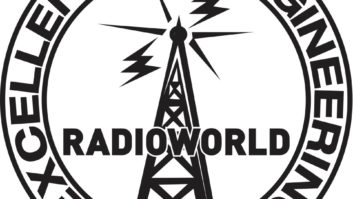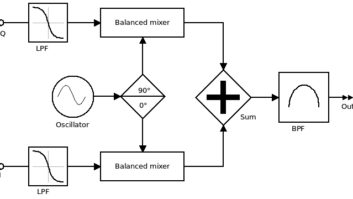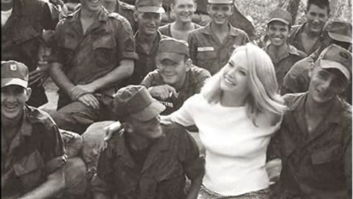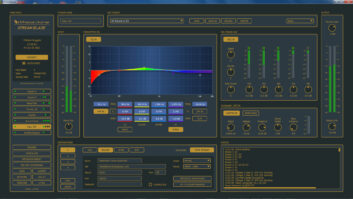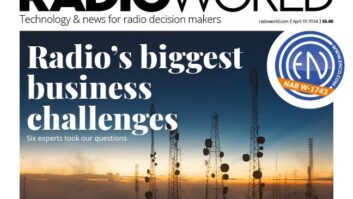The possible effects of audio processing on Portable People Meter measurements were the topic of two presentations at the NAB Show Broadcast Engineering Conference this spring.

Telos Alliance Senior Algorithm Developer Cornelius Gould said there have been a number of attempts by various experimenters to try to format and process radio programs to achieve the same benefit as verbal repetition of station ID and call letters.
Credit: Images courtesy of Telos Alliance Cornelius Gould, senior algorithm developer for Telos Alliance, introduced the subject with a discussion of the concepts behind watermarking. Dr. Barry Blesser followed up with a presentation that delved more deeply into the technology behind watermarking and potential weak points that he said may cause some stations to underperform with this form of measurement.
Both discussed the background for development of the Voltair, an audio monitoring product from 25-Seven Systems, which is part of Telos. The company says its product can assist stations in determining how to process their audio programming for best performance with embedded audio watermarks. Both Gould and Blesser said that they have no specific knowledge of Nielsen’s watermarking technology and that Telos Alliance and Nielsen were working cooperatively to determine what effects, if any, the Voltair has on Nielsen’s PPM measurement system.
HIGH PROFILE
There are 48 radio markets in the United States that obtain ratings estimates via Nielsen’s PPM system. They include the nation’s largest markets. Diaries are still used in the majority of close to 300 radio markets; respondents report their listening habits during a sample week in a given market.
Under the diary, stations realized it was important to provide a high profile to their identity on-air. Announcers were required to give out a recognizable station ID and call letters at every opportunity, according to Gould.
For stations being measured with PPM, a representative watermark can be detected via an electronic monitor worn by a listener. The watermark is designed to be inaudible to listeners so that it does not interfere with the audio.
While the primary determinant of listenership is going to be good radio programming, under PPM it is also important to ensure the electronic monitor operates to capture this “inaudible” watermark accurately; otherwise a potential listener may not be counted, Gould said.
To remain inaudible, the watermark technology relies on the concept of audio masking, according to Gould. He compared the watermark to a needle in the haystack of an audio signal. The PPM monitor, designed to extract needles, is able to locate the audio watermark, while humans listening are unable to discern it within the larger stack of audible information in a radio program.
To keep the watermark inaudible, the PPM encoder will not add it to the program audio unless its internal masking algorithms determine it will not be heard, according to Gould. As an extreme example, during silence the encoder has no audio available for masking and it will not be able to insert any watermarks because there is no haystack under which to hide the needle, he said.
HELP NOT HURT
In the PPM era, he said, there have been a number of attempts by various experimenters to try to format and process radio programs to achieve the same benefits that verbal repetition of station ID and call letters did for diary reports. Diary-oriented techniques offer no benefit in the presence of an electronic monitor that automatically identifies the station; such formatics could actually impair the PPM results, he said.
Concepts tried by stations have included the elimination of voice breaks without music underneath, the use of reverb, the use of specialized automatic gain control in the band of frequencies used by PPM, and even equalization of station audio in an effort to provide just the right “contour” that would allow the PPM monitor to respond, Gould said. These attempts basically were guesses, limited by the lack of a measurement tool that could provide a real-time answer as to whether they had any effect, Gould said. That lack of certainty, according to the Telos Alliance, led it to investigate the possibility of developing such a tool.
It used environmental monitoring to simulate the effects of listener location on the effectiveness of watermark detection in the presence of background noise, such as a car being driven at 65 miles per hour or in a kitchen with television programs in the background, combined with other household noises such as cooking or cleaning. From this research came the Voltair processor, now being offered by 25-Seven. It is designed to quantify in real time the environmental impacts on watermark detection as well as the effects of changes in the audio processing, Gould said.

Telos used environmental monitoring to simulate the effects of listener location on the effectiveness of watermark detection in the presence of background noise.
Telos concluded that audio processing could, in fact, affect the performance of the PPM encoder. Initially, Nielsen client stations were instructed to insert their watermark encoding at a convenient line-level input in the radio station audio chain. But Telos recommends using multi-band AGC before the encoder, which it says provides more opportunities to mask a watermark.
MASK VS. DECODER
In a separate session, Dr. Barry Blesser, director of engineering for 25-Seven, provided a more technical presentation of the details of audio watermarking. (Blesser prefaced his comments by saying they concerned watermarking systems in a general way but had no specific reference to the precise details of the watermarking system employed by Nielsen in its PPM system.)
Blesser said that in order for stations to record successful ratings estimates, both channels of a two-channel communication system are required to perform well.
To ensure that 100 percent of all the transmitted watermarks are received by monitors, stations can transmit a signal with watermarks at audible levels, but the resulting tones on top of audio with tones mixed in is unlistenable, and the station will not attract many listeners to measure, he said. Conversely, stations may have a large number of listeners attracted to their programming, but without good operation of the monitoring channel, their ratings estimates will suffer and few advertisers will believe them, he concluded.
In general, watermarking consists of a series of tones of changing frequency that carry some form of data. For Blesser, the key is whether sufficient audio energy exists to mask the intended watermarks properly without truncating important information. For example, in a typical watermarking system, tone duration will need to run about 400 milliseconds to allow a clean and clear decoding of the tone. If this tone is partially truncated, to perhaps 100 milliseconds, the result is a much lower signal-to-noise and a blurring of the line that determines which data tone is being fed. Tones truncated shorter than 25 milliseconds are un-decodable, no matter what kind of signal processing is used, according to Blesser.
A problem arises in real-world watermarking systems that rely on masking to hide the watermark tones, he argued. There is no way to predict if the program audio will have sufficient energy to mask a watermark for the entire tone length, and indeed there are some kinds of audio programming that when examined do not provide the correct energy in the key watermarking spectrum, he said. One way to help mitigate this problem is massive repetition of the watermark signals to increase the chance that uncorrupted signals reach the intended monitor, but there is no guarantee that will work.
MEASURE AND FINE TUNE
The development of the Voltair was an attempt to help understand how watermarking is affected by different types of program material. Blesser emphasized that the Voltair is an emulation of a watermarking system but that it does not employ any of the technology or intellectual property of the PPM system.
The Voltair can perform observations of the audio and the encoder output, but it is not able to tell the user precisely what will be received at a PPM monitor.
How can the Voltair be used to determine how a given change in program processing could affect PPM ratings estimates? Blesser suggested using a technique that varied an element, such as the settings of an audio processor, between two levels on odd and even minutes.
Statistically, the results should be reasonably consistent, since the number of samples at similar dayparts and times would be sufficient to characterize the system performance once the audience estimates are available, typically in three weeks.
After analysis, the change in audience estimates between these two settings (if any) allows the station to predict to what degree further, and perhaps more drastic, changes in processing will do to the ratings, based on a linear extrapolation of the results of the two different program settings, according to Blesser. Essentially, the Voltair allows stations to numerically measure the effects of changes to an emulated watermarking system in order to fine-tune its operation.
The author is manager of broadcast systems at WBUR(FM), Boston, and a longtime Radio World contributor.





